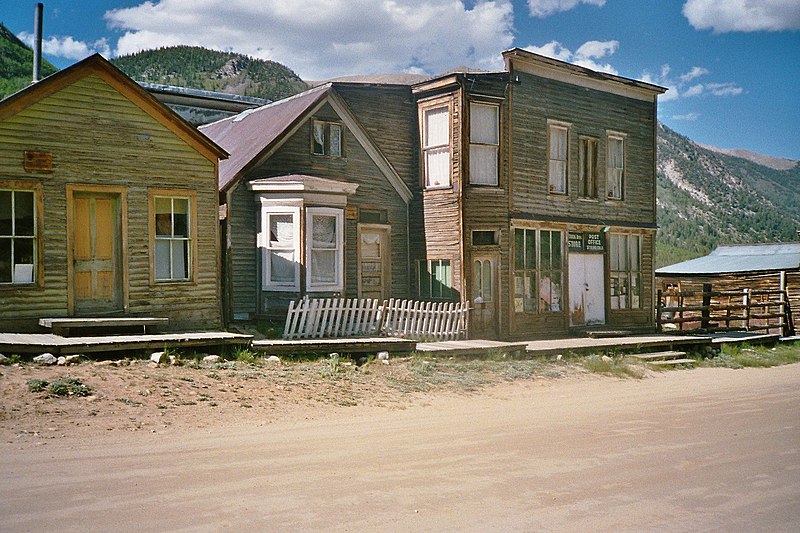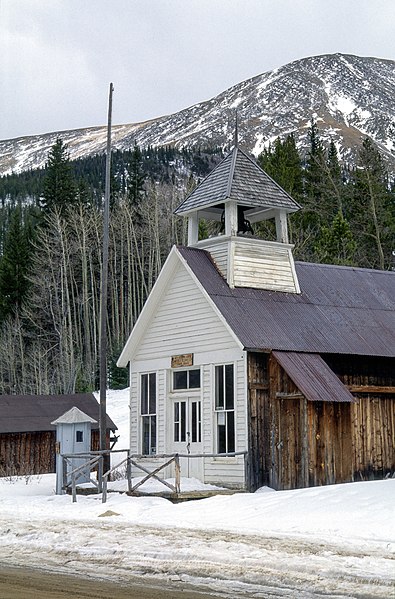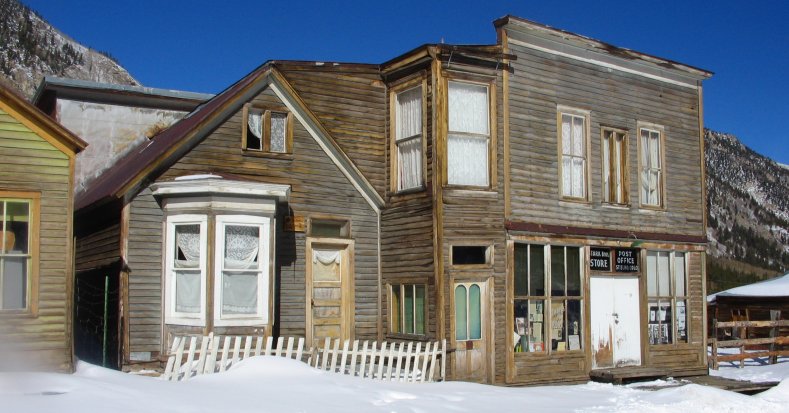St. Elmo, CO
Established in the late 1870s, St. Elmo was once a highfalutin gold mining town and popular whistle -stop on the Pacific Railroad. It boasted 2,000 residents, 130 mines, and enough hotels, brothels, saloons, and dance halls to keep everybody in town happily cutting a rug. When the Alpine Tunnel closed in 1910, however, the piano music stopped.
Today, there’s little left save a cabin where you can stay and a general store (open during the summer) that sells antiques and rents four-wheelers.
History
Due to the large number of towns with the same name, St. Elmo’s original name was changed to St. Elmo. Griffith Evans, one of the founding fathers, picked the name St. Elmo upon reading a book with the same name.
A telegraph office, general store, town hall, five hotels, saloons, dancing halls, a newspaper office, and a school were all there when the town was at its busiest in the 1890s. The St. Elmo Mountaineer, the town’s earliest and longest-running newspaper, started covering the mining industry in August 1880 and operated until 1895. St. Elmo was on the Denver, South Park and Pacific Railroad line. Within the region, there were 150 patented mine claims. The Pioneer Mines, Teresa C, Mary Murphy, or The Molly employed the bulk of the residents of St. Elmo. The largest and most productive mine in the region was the Mary Murphy Mine. During its existence, the Mary Murphy Mine extracted gold worth more than $60,000,000. The Mary Murphy Mine remained operational until the railroad was abandoned in 1922, while the other mines finally closed.
When the mining business collapsed, St. Elmo’s population fell precipitously. In addition to closing down, the St. Elmo commercial district was abandoned as miners looked for gold and silver elsewhere. Few individuals remained in the town to dwell. After the postmaster of St. Elmo’s passed away in 1952, mail delivery was stopped.
St. Elmo today

https://commons.wikimedia.org/w/index.php?title=User:Dk4hb&action=edit&redlink=1
St. Elmo is still inhabited; however, it is regarded as a ghost town. The former mine roads are now used as off-road vehicle paths, and St. Elmo is a popular tourist destination. Chalk Creek, which flows through St. Elmo, has areas where fishing is possible. During the summer, visitors may purchase goods or hire off-road vehicles at the general shop. Although the town hall and a few other buildings were destroyed by fire in 2002, several structures still stand today. The town hall is being restored to its original condition by Buena Vista Heritage.
St. Elmo is shielded from government initiatives by its National Register classification, yet nothing stops private development there. Before St. Elmo was designated as a historic monument, a development company by the name of Consortium B purchased land nearby with the intention of developing it into a ski resort in the 1960s. However, a prolonged drought disrupted that plan, and the Milam Trust eventually bought most of the developer’s land. The American International Metal Company then leased the Mary Murphy Mine and intended to revive it in the early 1980s when gold and silver prices rose. The firm abandoned the project because the location got too much snow for mining to be profitable there, so it rapidly dismantled the ancient mine buildings and mill under the pretext that they were an insurance obligation.
Fire is arguably the biggest hazard to St. Elmo’s wooden structures. Five structures in St. Elmo were destroyed by a significant fire in April 2002, including the town hall, which was constructed in the early 1890s and had previously withstood multiple fires. Following the fire, the charity Buena Vista Heritage received ownership of the destroyed town hall and schoolhouse from the St. Elmo Property Owners Association. In 2004–2005, Buena Vista Heritage renovated the schoolhouse with funding from a State Historical Fund grant and private contributions. The schoolhouse was then reopened to the public as the St. Elmo Schoolhouse Museum in June 2006. Buena Vista Heritage started rebuilding the burned-out town hall in 2006. The brand-new town hall structure, which was finished in 2008, also serves as a local history museum.
In order to promote more preservation efforts in the region, Melanie Roth and others founded a new nonprofit organization named Historic St. Elmo and Chalk Creek Canyon in 2010.
Getting there
Leave Buena Vista and head south on Highway 24. Once you pass Nathrop, look for County Road 162 on the right. Travel 19 kilometers on Co Rd 162 to reach St Elmo. Along the route, you’ll pass Mt. Princeton Hot Springs and Agnes Vaille Falls, a quick waterfall trek.
If you have more time, you may investigate Hancock and Mary Murphey Mine, two ruins near St. Elmo. The greatest option for traveling across Tincup Pass and exploring Pitkin, Tincup, and Ohio City is to own a 44 or hire a Jeep. All were completed quickly in one day. On Co Road 162, camping is not permitted.
Geography
The site is situated in Chaffee County, Colorado, at 38°42′17′′N 106°20′53′′W, at an elevation of 10,006 feet (3050 m).

https://commons.wikimedia.org/wiki/User:Darekk2
General Store & Town of St. Elmo
The Denver, South Park, and Pacific Railroad line passed through the town during its height, and there were more than 150 mining claims that had received patents. Unfortunately, the mining business started to deteriorate after barely 40 years, and once the train ceased operating in 1922, the town was abandoned. The miners first departed to look for gold elsewhere. The remainder of the populace thereafter gradually dispersed until the postmaster of St. Elmo’s passed away in 1952. The death knell for St. Elmo’s Main Street was struck by that. The National Register of Historic Places now includes the St. Elmo Historic District. But that is not where the narrative ends…
St. Elmo still has residents despite being regarded as a “ghost town,” and the town receives a large influx of visitors each year. In addition to fishing and ATV tracks, the general shop is open all summer. The town hall burnt down in 2002, as predicted in the John Parr classic “St. The Elmo’s Fire. You may now spend the night in an actual cabin during your stay to St. Elmo for just $79 per person. could spend less than $500 to rent it for a week.
What Not to Miss
You must go to the General Store and the Home Comfort Hotel. These two buildings are neatly kept and have lace window treatments along St. Elmo’s major thoroughfare, Poplar Street. Even though I would have delighted to see “Dirty Annie” (described below) peering out of the upper window, I did not want to alarm her. The eerie serenity of these windows gave me the chills. The contemporary St. Elmo inhabitants state that they are aware that Dirty Annie would defend their community, but they are concerned that they are unaware of the extent of her protection.


